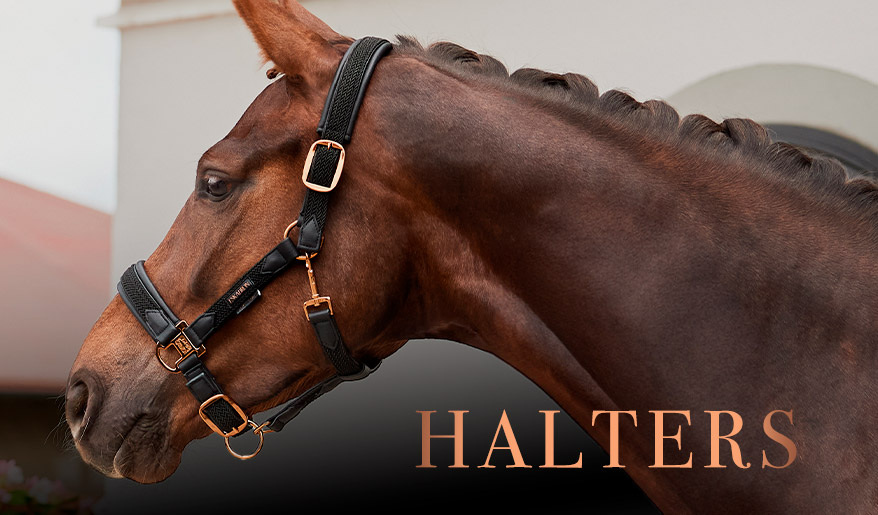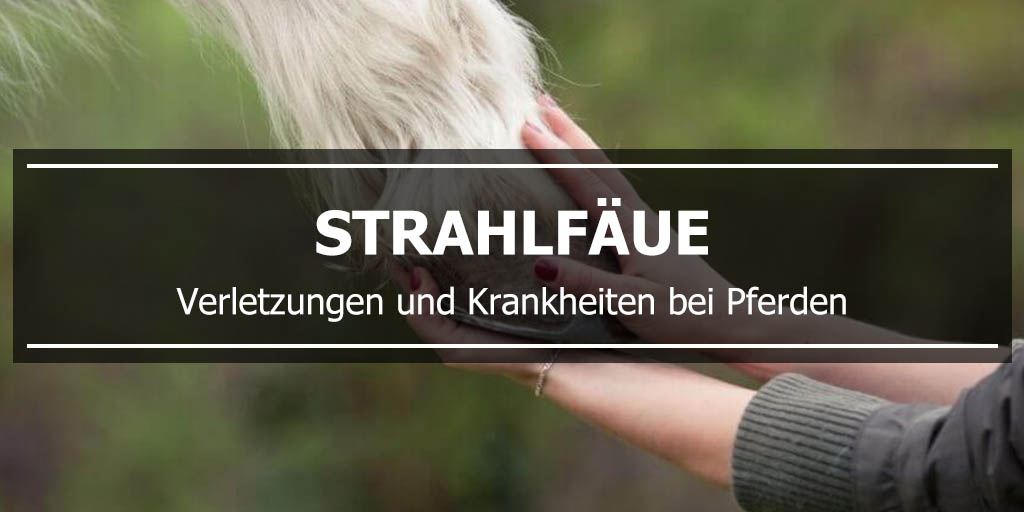
Hintergrundquelle: pets4homes.co.uk
„Ohne Huf kein Pferd“, sagt ein altes Sprichwort. Man sollte sich darüber im Klaren sein, wie wichtig ihre Pflege ist, denn viele Krankheiten und Verletzungen, für die Pferdehufen anfällig sind, werden durch unser Verschulden oder Vernachlässigung verursacht. In diesem Artikel lernen Sie die Liste der Bedrohungen kennen, die für Ihr Pferd betreffen können, und wie Sie sich effektiv davor schützen.
Wie ist ein Huf aufgebaut?
Der Pferdehuf ist eine komplexe und komplizierte Struktur. Von außen ist er mit einem Horn umhüllt, das im Inneren das Kronbein, Hufbein und Fesselbein mit Sehnen schützt.
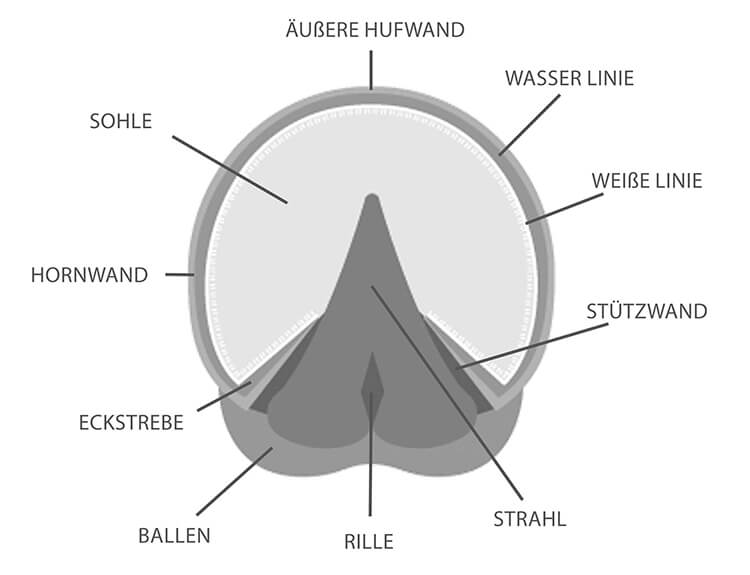
Hufaufbau
Denken Sie daran, dass das erste und wichtigste, wenn Sie Symptome bemerken, die auf eine Krankheit oder Verletzung des Hufes hindeuten könnten, immer eine schnelle Konsultation mit einem Tierarzt sein sollte. Ein Pferd alleine zu behandeln kann oft mehr schaden als helfen.
Nachfolgend geben wir eine Liste der häufigsten Pferdehuferkrankungen und -verletzungen an. Die Informationen, die Sie finden, dienen nur zur Beurteilung des Pferdezustands, der Krankheiten, Symptome, Behandlungsart und vor allem: der Prophylaxe und Vorgehensweise mit einem kranken Pferd bis zum Eintreffen des Tierarztes.
Strahlfäule
Oft als „Vernachlässigungskrankheit“ bezeichnet.
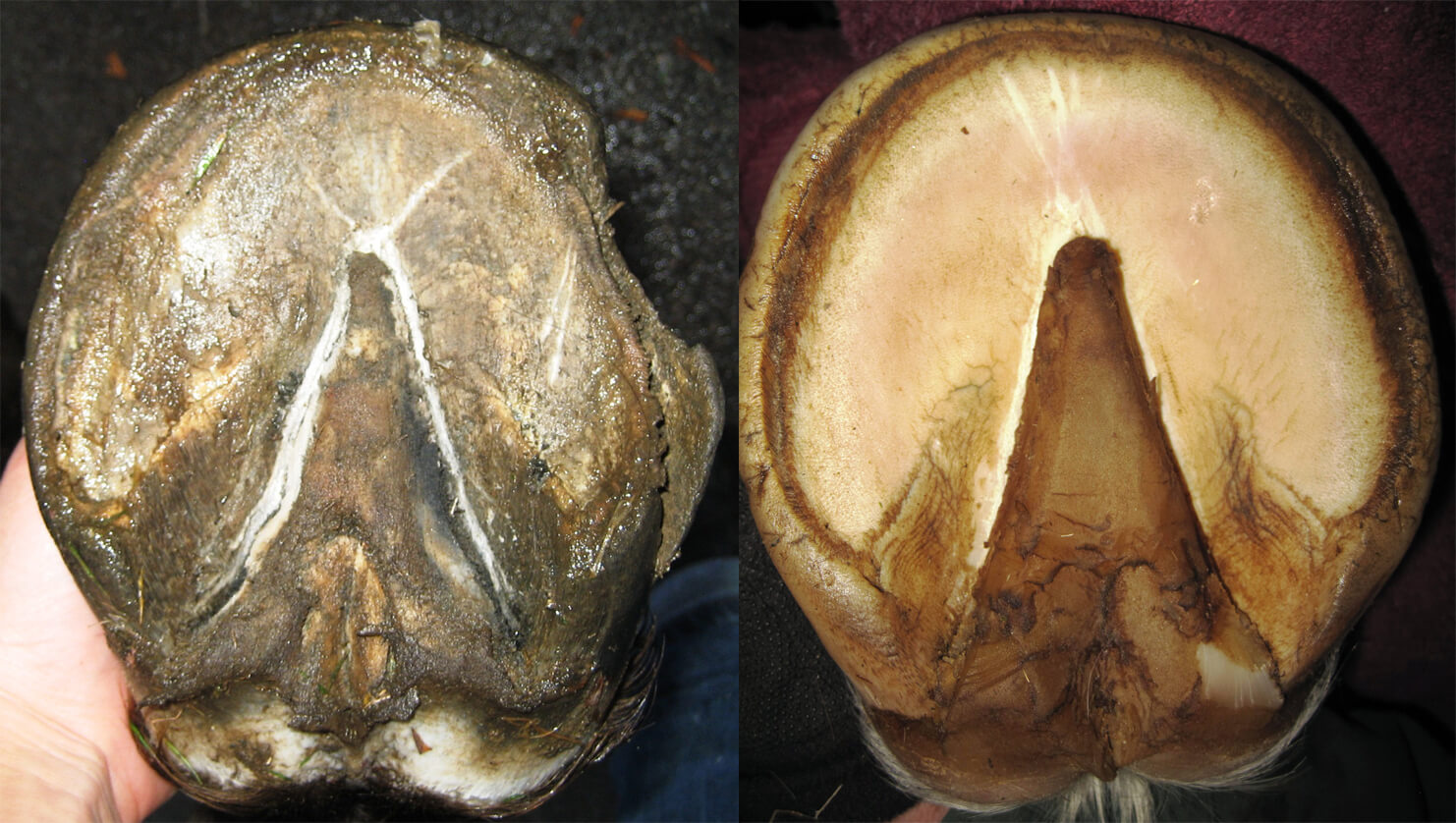
Strahlfäule vor (links) und nach der Korrektur (rechts), Quelle: heikebean.com
Ursachen:
- Der Faktor, der das Fäulen verursacht, sind Bakterien oder Pilze, deren Entwicklung durch die tiefe zentrale Strahlrille begünstigt wird, die bei einem engen Huf auftritt
- Haltung des Pferdes in feuchter und tiefer Einstreu
- unsachgemäße oder fehlende Hufpflege
- verringerte Immunität des Pferdes
- unsachgemäßes Beschlagen
Symptome:
- Die Strahlrille ist mit einer klebrigen grauschwarzen Schmiere mit einem unangenehmen fauligen Geruch gefüllt
- das Horn des Hufbeins ist sehr weich, es kann in Stücken abfallen, es lässt sich leicht trennen
- Das Pferd empfindet beim Reinigen des Stahls Schmerzen, ist unruhig und regt sich auf und reißt den Huf weg
- Wenn die Krankheit bereits weit fortgeschritten ist, können graue Massen auf dem Strahl erscheinen, was auf Strahlkrebs hinweist
- in der fortgeschrittenen Entwicklung der Krankheit kann Lahmheit auftreten
Behandlung:
- Stellen Sie Ihr Pferd auf einen trockenen Boden, richten Sie eine Box ein, die mit sauberem Stroh gefüllt wird
- Reinigen Sie die Strahlrille gründlich mechanisch und desinfizieren Sie sie und ihre Umgebung
- Sie können die Strahlrille mit Kupfersulfat füllen (erhältlich in Form von Salben oder losen Kristallen - letzteres sollte mit Vaseline kombiniert werden, um das Auftragen zu erleichtern und damit das Mittel möglichst lange im Strahl bleibt - man sollte es mit einer gewöhnliche Spritze zum schnellen Auftragen des Mittels verwenden); Stopfen Sie dann die Rille mit Watte und drücken Sie sie ganz fest hinein, damit sie nicht zu leicht herausfällt
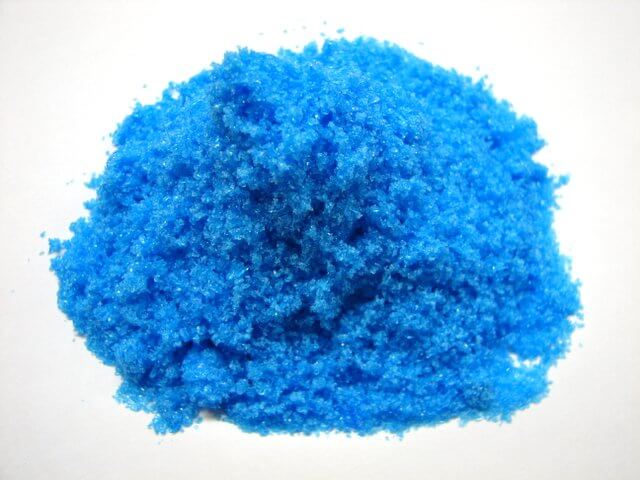
Kupfersulfat mit charakteristischer blauer Farbe, Quelle: dnepropetrovsk.flagma.ua
- es gibt auch fertige Präparate zur gleichzeitigen Pflege und Regeneration des Hufhorns, die während der Behandlungs- und Prophylaxe Phase verwendet werden können (z. B. Keralt Strahl-Liquid)
- wenn die Rille nur weich ist, ohne sichtbaren Ausfluss, können Sie es mit Teer versuchen, einer Art Holzteer (nicht öfter als einmal pro Woche verwenden)
- wenn die Krankheit fortgeschritten ist und Ihr Pferd humpelt - rufen Sie einen Tierarzt an, weil wahrscheinlich die faulen Teile des Horns entfernt und die Fäulnisbeutel herausgeschnitten werden sollten
- denken Sie daran, dass die Behandlung langfristig ist
Vorbeugung:
- stellen Sie sicher, dass Ihr Pferd eine regelmäßig gewechselte Einstreu in der Box hat
- es gibt keine bessere Vorbeugung als häufiges Paddock Reiten des Pferdes auf trockenem und grasbewachsenem Untergrund
- tägliche Hufreinigung
- einmal pro Woche kann prophylaktisch ein spezielles Pflegemittel für den Strahl verwendet werden (z.B. Keralt Strahl-Liquid)
- achten Sie auf die richtige Ernährung Ihres Lieblings
- sorgen Sie für die richtige Hufkorrektur - richtiges Beschlagen, ständige Überwachung des Hufeisenzustands, Anbringen von Hufnägeln usw.
Nageltritt
Ursachen:
- Durchstechen der Hufsohle mit einem scharfen Gegenstand, z.B. einem Nagel oder Glas; Je nach Lage und Tiefe des Nagels kann das Hufmaterial, sowie tiefer liegende Strukturen beschädigt werden (Sehne, Gelenk oder Knochen)
Symptome:
- Lahmheit, Schmerzen, Blutungen, Eiterung und Schwellung
- das Pferd versucht, das schmerzende Bein zu schützen, indem es sein Gewicht auf die anderen Beine verlagert
- oft hebt das Tier sein Bein und lässt den Huf nicht den Boden berühren
Behandlung:
- informieren Sie sofort Ihren Tierarzt!
- entfernen Sie die Fremdkörper nach Möglichkeit, waschen und desinfizieren Sie dann die Umgebung der Wunde (z. B. mit Jod oder Rivanol) und decken Sie alles steril ab
Vorbeugung:
- kontrollieren und reinigen Sie gründlich nach der Rückkehr vom Reiten, aus dem Feld oder vom Paddock die Pferdehufen
- versuchen Sie, das Pferd nur auf einer bekannten und vorbereiteten Oberfläche zu reiten - auf der Manege und auf bewährten Pfaden in der Umgebung
- erlauben Sie keinen Konsum von Getränken in Glasbehältern auf dem Gelände der Reitanlage
- sammeln Sie nach renovierungsarbeiten im Stall, auf dem Paddock Schrauben, Nägel, Drahtstücke, Bleche etc. sorgfältig auf
Hufrehe
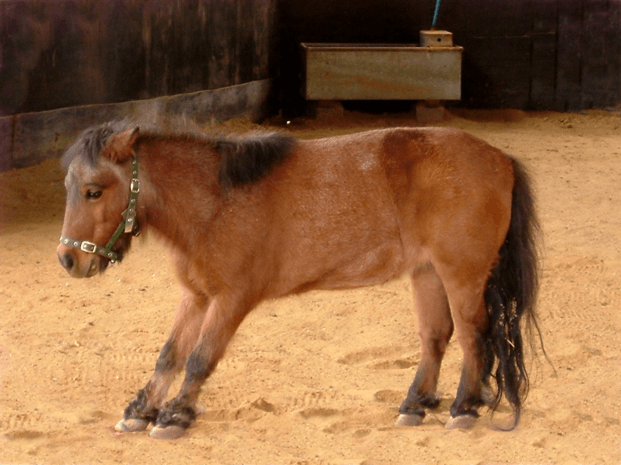
Charakteristische Haltung eines Pferdes mit Hufrehe, Quelle: animalclinicww.com
Ursachen:
- übermäßige Zufuhr von Kraftfutter (Getreide, z. B. Gerste, Hafer) - bei Bewegungsmangel
- zu eiweißreiches Futter (z. B. zu viel Grass zu Beginn der Weidesaison)
- wenn man ein erhitztes Pferd nach dem Training mit kaltem Wasser tränkt, besonders wenn es nicht daran gewöhnt ist
- wenn man ein erhitzte Pferd kalt oder in einem Luftzug lässt
- zu intensive Bewegung auf hartem Untergrund
- falsches Beschlagen
- postpartale Anomalien bei Stuten (Plazentaretention)
- Vergiftungen unterschiedlicher Herkunft (Durchfall und andere Erkrankungen des Verdauungssystems)
Symptome:
- heiße und berührungsempfindliche Hufe
- charakteristische Haltung mit nach vorne gestreckten Vorderbeinen
- Schwierigkeiten beim Bewegen, insbesondere auf harten Oberflächen
- es wechselt von einem Fuß auf den anderen und versucht, sich hinzulegen
- wenn nur die Vorderbeine krank sind, nimmt das Pferd eine Position ein, die einem sitzenden Hund ähnelt
- wenn das Pferd zur Bewegung gezwungen mit den Beinen schlurft und zuerst den hinteren Teil des Hufs (den Ballen) aufsetzt
- hohe Temperatur
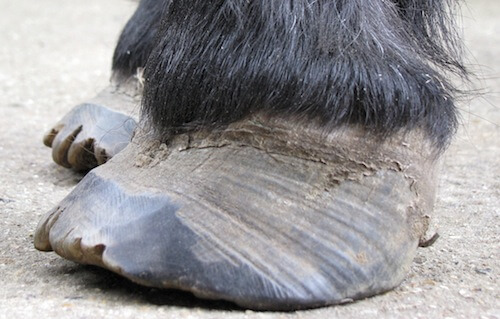
Huf nach Durchlaufene und unbehandelte Hufrehe, Quelle: hoofcare.blogspot.com
ACHTUNG!
Eine zu späte oder unsachgemäße Behandlung führt zu tiefgreifenden Veränderungen des Horns.
Behandlung:
- Rufen Sie sofort einen Tierarzt an!
- bieten Sie dem Pferd so schnell wie möglich eine ständige Hufkühlung (mit Wasser gießen, Eisumschlag oder man kann versuchen, dem Pferd einen "Schwimmbecken" zu schaffen - d.h. man sollte die Einstreu aus der Box nehmen, dann mit Folie füllen und Wasser hineingießen)
- führen Sie Ihr Pferd kurz in kurzen Abständen, um die Durchblutung in den Beinen anzuregen
- nur eine spezialisierte, intensive Behandlung kann zufriedenstellende Ergebnisse erzielen
- die Behandlung stellt den Nutzwert des Pferdes vor der Erkrankung oft nicht wieder her
Vorbeugung:
- vermeiden Sie Faktoren, die eine Hufentzündung auslösen können
- wählen Sie die Futterdosis entsprechend der Rasse, dem Geschlecht, dem Alter, der Verwendung und dem Bewegungsumfang Ihres Tieres
- befolgen Sie alle Empfehlungen zur Prophylaxe von Magen-Darm-Erkrankungen
- achten Sie auf die richtige Korrektur und das Beschlagen Ihres Pferdes
Beschädigung des Hufes von unten
Ursachen:
- Arbeit von unbeschlagenen Pferden auf hartem, felsigem Boden
- ein nicht entfernter Stein, der zwischen dem Huf und dem Hufeisen steckt
Symptome:
- Lahmheit, erhöhte Huftemperatur, Gefühlsempfindlichkeit mit Huffühlern
Behandlung:
- wird je nach Läsionen von einem Tierarzt vorgenommen
Vorbeugung:
- arbeiten Sie nicht mit einem unbeschlagenen Pferd auf hartem oder felsigem Boden (wenn Sie auf der Weide auf diese Art von Boden treffen, reiten Sie darüber im Schritttempo oder steigen Sie sogar ab und führen Sie das Pferd)
- Reinigen Sie bei der täglichen Pflege die Hufe gründlich und befreien Sie sie von Fremdkörpern
- kontrollieren Sie das richtige Beschlagen
Vernagelung
Ursachen:
- zu tiefes Eindringen in des Hufnagels, der die Hornschicht des Hufs drückt und manchmal durchsticht
Symptome:
- Schmerzen im Bereich eines schlecht eingeführten Hufnagels, Lahmheit
Behandlung:
- benachrichtigen Sie den Tierarzt
- entfernen Sie den schmerzenden Hufnagel, wenn dies möglich ist (man verwendet an seiner Stelle keinen neuen!), desinfizieren Sie danach das Loch und binden Sie es steril ab
Zapobieganie:
- vertrauen Sie das Pferdebeschlagen einem qualifizierten und bewährten Schmied an
Entzündung des Sesambeins
Ursachen:
- Überlastungen im Bereich der Zehen der Vorderbeine
Symptome:
- skracanie wykroku, sztywny krok, niechęć do skoków, chwilowa poprawa po kilku dniach odpoczynku
Behandlung:
- benachrichtigen Sie den Tierarzt
- sie dauert lange und ist teuer
- erfordert spezielles Beschlagen
Vorbeugung:
- versuchen Sie, den Bewegungsapparat des jungen Pferdes nicht zu überlasten
- Früherkennung der Krankheit erhöht die Chancen auf eine erfolgreiche Behandlung
Zatraty
Ursachen:
- mechanische Verletzungen der Hufkrone oder Huftrachten, die oft durch schlecht ausgewählte Gamaschen oder Pferdeglocken verursacht werden, oder wenn Pferde miteinander rennen (mit den Hinterbeinen auf die vorderen Trachten treten) und Streichen (wenn Vorderbeine und Hinterbeine im inneren Bereich aneinander reiben)
Symptome:
- offene Wunden der Krone oder des Ballens
ACHTUNG!
Pferde, die mit Hufstollen beschlagen sind, können ernsthafte Schäden verursachen.
Behandlung:
- benachrichtigen Sie den Tierarzt
- desinfizieren Sie den Schnitt und legen Sie einen sterilen Verband an
Vorbeugung:
- schrauben Sie nach Trainingsende immer die Hufstollen ab (auch vor dem Transport!)
- halten Sie beim Reiten ausreichend Abstand zu anderen Pferden
- schützen Sie die Kronen und Ballen richtig ausgewählten Pferdeglocken (z.B. ESKADRON Glocken)
Wie pflegt man die Pferdehufe?
- Denken Sie daran, die Hufe vor dem Reiten und nach der Rückkehr in den Stall gründlich zu reinigen
- Achten Sie darauf, dass die Einstreu in der Box Ihres Tieres regelmäßig gewechselt wird.
- Bewege dich zu Pferd nur auf dem für das Reiten geeigneten Untergrund - Manege und bewährte Pfade im Gelände.
- Schrauben Sie die Hufstollen immer nach einem Ausritt oder einem Start und vor dem Transport ab.
- Halten Sie während des Trainings ausreichend Abstand zu anderen Pferden.
- Pflegen Sie regelmäßig die Strahlen und Hufrille mit Teer oder anderen speziell dafür entwickelten Produkten.



 Hintergrundquelle: pets4homes.co.uk
Hintergrundquelle: pets4homes.co.uk
 Strahlfäule vor (links) und nach der Korrektur (rechts), Quelle: heikebean.com
Strahlfäule vor (links) und nach der Korrektur (rechts), Quelle: heikebean.com
 Charakteristische Haltung eines Pferdes mit Hufrehe, Quelle: animalclinicww.com
Charakteristische Haltung eines Pferdes mit Hufrehe, Quelle: animalclinicww.com Huf nach Durchlaufene und unbehandelte Hufrehe, Quelle: hoofcare.blogspot.com
Huf nach Durchlaufene und unbehandelte Hufrehe, Quelle: hoofcare.blogspot.com
